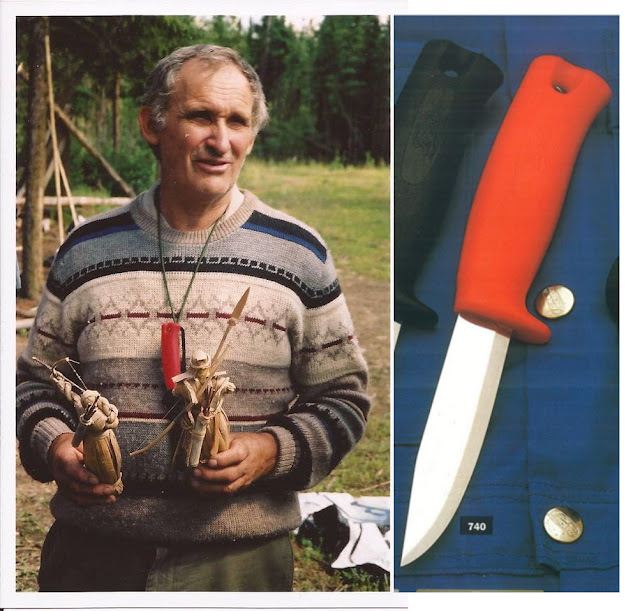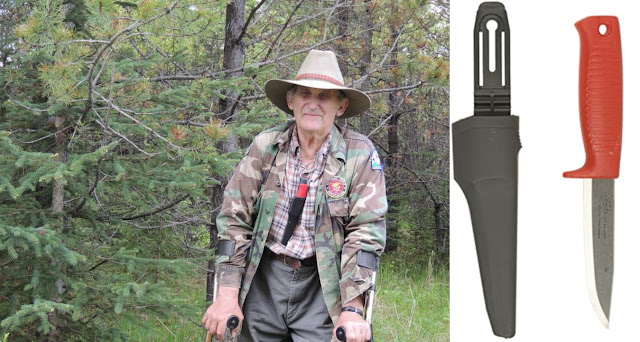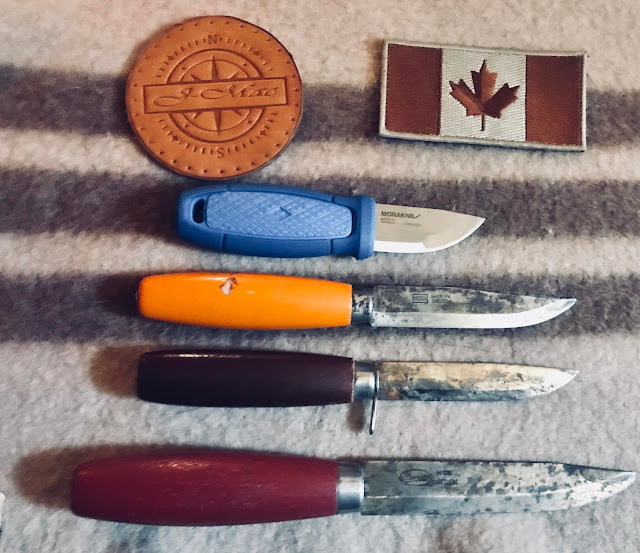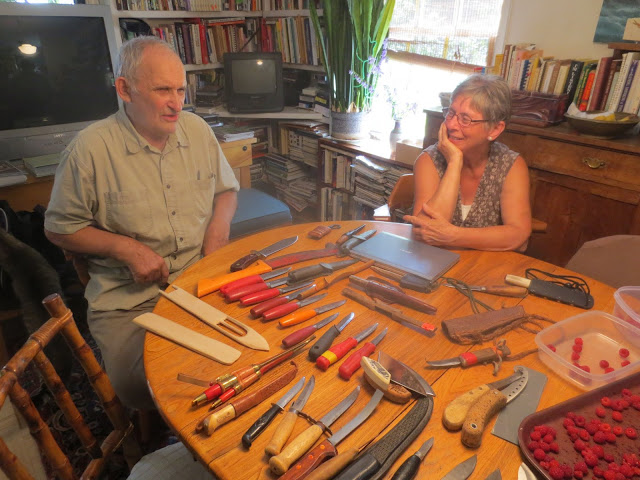IN MEMORY OF Mors Kochanski (1940-2019)
The legendary Mors Kochanski is considered by many to be the father of modern “bushcraft”. He has devoted his entire life to studying and teaching bushcraft and survival skills.
Mors is also an acclaimed author with many books published, among them the Northern Bushcraft (1988- ISBN 1-871890-30-6) the bible for those who study and practice these skills.
He's saying “the more you know, the less you carry” has become a motto for the bushcraft community, and his knife preferences are an example of this.
To know more about his life visit https://en.wikipedia.org/wiki/Mors_Kochanski or even better, listen to Paul Kirtley's podcast episode, where he interviews Mors https://paulkirtley.co.uk/2019/mors-kochanski-paul-kirtley-podcast/.
Early in his career as a survival teacher, he and Tom Roycraft (probably late 1960s) put together the requirements of a basic yet practical knife for his students to use: blade around 4 fingers long, with a continuous curve and with a tip that allows making holes. Handle that fits well in the hand and gives reference to the direction where the cutting edge is facing.
He made these knives himself, from big band saw blades in the school grounds with very simple tools.
In the article "wilderness blade" for Field & Stream magazine from 2004, Mors writes: "The knife is the balance point for survival in the bush.". Without it, you have to stay on the move. With it, you create the opportunity to rest.”
In the 1980s, Mors began using Mora knives. He bought them from a local camping outfitter in Edmonton.
The Mora knife would fulfill all the requirements he defined years before, inexpensive, well built, and easy to maintain by his students in the field.
For many years his choice was the classic N.1, from both Frost and KJ Eriksson.
According to Jonathan McArthur “Mors really spoke highly of the knives from the Mora region. Later when Morakniv started making the outdoor line, it was the Eldris that really spoke to him. He really liked it over the Kansbol and Garberg.”
For many years he carried the classic N.1 until he discovered the KJ Eriksson 511.https://oldmora.blogspot.com/2021/08/KJE-510-511.html
Thru out the years, he was seen carrying several different models from both KJE and Frost and later on from Morakniv.
 One of the knives that used to belong to Mors was a re-handled 511 that a fellow instructor had done. On the Canadian Ranger Survival course, they made the old-school birch bark sheaths. Kelly Harlton made up and gave to Mors for his new knife. This knife was given by Mors to Jonathan McArthur's wife.
One of the knives that used to belong to Mors was a re-handled 511 that a fellow instructor had done. On the Canadian Ranger Survival course, they made the old-school birch bark sheaths. Kelly Harlton made up and gave to Mors for his new knife. This knife was given by Mors to Jonathan McArthur's wife. He also liked to make birch bark sheaths for these knives. In this video from 2010, Mors shows how to make a birch bark sheath for a KJE 511. https://www.youtube.com/watch?v=0naI_ss9CbY
Most of the KJE 511 Mors were modified to best suit his needs
• The finger guard was sawn off
• The spine was sharpened to aid in scraping ferro rods
• Hole at the end of the handle to attach a string to help in case the knife get dropped on the snow
• Hole in the middle of the handle, for a wrist lanyard
Ear Mors explains these modifications https://www.youtube.com/watch?v=ehjbNLy387k
 In International Survival Conference that took place in Sweden in 1995 is seen using a Frost 700 and a KJE 510/511. Full video here https://youtu.be/u6Vr6v6ZCeM.
In International Survival Conference that took place in Sweden in 1995 is seen using a Frost 700 and a KJE 510/511. Full video here https://youtu.be/u6Vr6v6ZCeM.
 Mors and Cody Lundin in the Rabitstick randevu, both are known Mora knives users. Mors has around his neck a 511 sheath.
Mors and Cody Lundin in the Rabitstick randevu, both are known Mora knives users. Mors has around his neck a 511 sheath. Some videos where Mors talks about his preferences regarding knives
Mors Kochanski on Knives Part 2 https://www.youtube.com/watch?v=BO0WX-aZGLw
Mors Kochanski "Knives I've Used Throughout my Life" https://www.youtube.com/watch?v=-BXKHRzn_yE
What is a Survival Knife? https://www.youtube.com/watch?v=Lll-4jDAVzA
Mors Kochanski Survival Knives https://www.youtube.com/watch?v=14hrK7XCpSs
Knives in My Livelihood as a Survival Instructor https://www.youtube.com/watch?v=nxuBi0Ci1eM
Other knifemakers later found him and built knives around his ideas. Two knifemakers distinguish from all the others: The Skookum Bush Tool by Rod Garcia from Whitefish, MT, USA, and the Canadian Forest Knife by James Andal, Prince George BC, CANADA. The Canadian Forest Knife was highly prized by Mors.

His legacy will perdure for many generations to come, thru many of his students like Kelly Harlton, Jonathan McArthur, and the rest of the instructors at the Karamat Wilderness Ways school (https://karamat.com) and all the instructors all over the world that he trained.
Special thanks to Jonathan Jonathan McArthur, personal friend and student of Mors, for his contributions to this article.
https://www.fieldandstream.com/articles/keith-mccafferty/2004/06/wilderness-blade/
Transcription of the article: “A knife is the most important tool that a man can take into the wilderness. It allows him to spark a fire, cut saplings to fashion shelter, or whittle the trigger for a figure-four deadfall trap. As master woodsman Mors Kochanski says, “The knife is the balance point for survival in the bush. Without it, you have to stay on the move. With it, you create the opportunity to rest.”
But what exactly is the ideal outdoorsman’s knife? Most survivalists cover the bases-and skirt the issue-by recommending two blades, a small knife for intricate work and a chopping blade for felling trees, limbing, and splitting wood. However, few hunters and fishermen carry axes. And in the right hands, a fixed-blade knife of modest dimensions can help a person fashion all the tools needed for living off the land. Kochanski’s concept of a bush knife won’t meet with universal agreement-there are few more hotly debated topics in survival forums-but it’s hard to dismiss the advice of a man who can topple a 7-inch-thick aspen tree in as little time as it takes to read this article, simply by pounding the point of his knife into the trunk and jerking the blade back and forth.
Points of Interest
The blade of your knife should be extremely strong, easily resharpened, and capable of holding a fine edge. If you can touch it to your throat and draw blood, whack it against a frozen deer bone without rolling the edge, and pound the tip 2 inches into a tree trunk at a right angle to the grain and stand on it without breaking it, you’ve got the prerequisites of a woodsman’s knife. In addition:
The blade should be as long as the width of your palm, with the metal extending the full length of the handle.
The back of the blade should run in a straight line with the back of the handle and be wide and flat so that it can be used with a baton (a stick used as a hammer).
The cutting edge should curve gently from tip to guard to facilitate sharpening, with the point falling in line with the center of the handle. It should also have a flat grind (hollow-ground blades bind when driven into wood). Serrations have no place on the blade of your knife-they can’t be resharpened easily and they occur on the part of a blade you need for most detail work.
A small, lower finger guard is acceptable but not necessary. An upper guard is an abomination, interfering with placing the thumb or forefinger along the top of the blade for control.
The butt should be flat and durable enough for you to pound on.
Many commercially made blades meet these requirements, but most are heavy and expensive. Kochanski, who conducts a school on bushcraft in British Columbia, recommends that his students learn basic skills with the Swedish-made Mora knife, which costs about $10 and has been the woodsman’s standard for centuries. A Mora is lightweight, so it can be carried on a cord around the neck (sheathed), where it’s least likely to be lost. In addition, several models are available with carbon rather than stainless-steel blades, which allows you to strike sparks with a flint.
Keep in mind that a knife is only as good, and as safe, as the person who wields it. Its primary functions-making traps, butchering game, rendering tinder, whittling bow drills, slicing wedges for log splitting, felling saplings to make shelter-demand skills that are best learned by studying with a master.”



















Hi Joao, thank you for writing a comprehensive survey of the knives that Mors favoured and could be seen using, as well as documenting the evolution of his preferences. It was very interesting to see the cross-fertilisation of ideas and knife use between Mors, the Scandinavians, particularly the Swedes, and the bushcraft movement in the UK too. The use of Mora knives specifically, along with the more general preference for blades approximately the width of the palm of the hand, such as the Woodlore knife, all come back to this intersection. Mors certainly has a great deal to be thanked for in terms of both his selection of simple, effective tools, as well as his low-cost practicality more generally.
ReplyDeleteWarm regards from the UK.
Paul Kirtley
If the simple Morakniv is today a "standard" knife in the bushcraft scene, it is in great part because of Mors. In a time where some of the other big names in the industry were designing strange "survival knives" that looked like inspired by Rambo, Mors went in the opposite direction. I think is Polish/European heritage played a huge role.
DeleteMors was probably the best educator of the subject that ever lived . Choosing a "common man" knife that anyone could afford is very in line with his principles of not trying to compensate for the lack of knowledge and technique with gear.
If we look beyond YouTube and social media, there are still a number of educators (you being one of them) with both the knowledge and the ability to communicate, who can continue to pass on knowledge without getting caught in the gear.
Joao
hello do you know which Mors knife is your favorite and which model would be recommended for a 3 week expedition?
DeleteIn terms of the knives MorsK used, I would choose the classic.
DeleteIt is important to consider a variety of factors when choosing a knife for a trip. For a 3 week trip, I would definitely pack 2 knives, not because I am afraid of breaking one but because the probability of losing one is much higher. Then it would depend on your travel method, on foot, canoe, sled etc. This would impact the amount of gear you can carry. If you can carry an axe and saw, I would recommend with something like a 2000, a classic or a companion. They are superior at small tasks such as woodworking, food preparation, etc. Another thing to consider is the environment, if you will be near salt water, then SS is a must. In every other environment, you can choose the one you like best, never forgetting that carbon needs a bit more care than SS.
Joao, great article as usual! Mora knives looks so simple and not fancy and at the same time so useful. Nowadays, when the EDC trend is so developed and everyone buying fancy knives it is so good to humble us with the great skill of one of the known greatest practician and theoretician of the bushcraft skills. The truth is in the skill and in the game how to use and enjoy using it, not in the tool itself. Thanks again for this important reminder of the old school real deal nature guys! Greetings from Bulgaria! Cheers
ReplyDeleteI think for decades now, we have been over compensating the constant reduction of knowledge with more specialized tools and gimmicks. This approach has lead, to the reduction of problem solving capability and critical thinking.
Delete